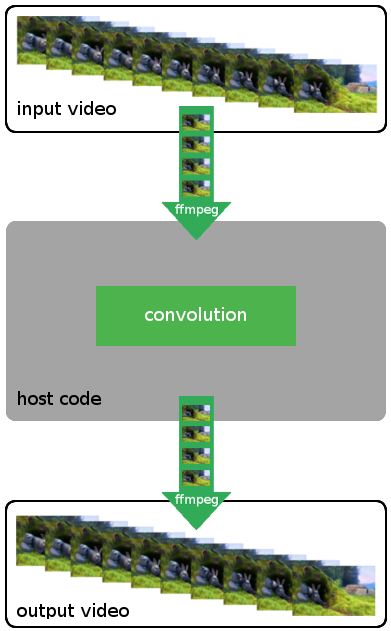 2020.1 Vitis™ Application Acceleration Development Flow TutorialsSee 2019.2 Vitis Application Acceleration Development Flow Tutorials |
1. Evaluating the Original Application¶
The C application used in this tutorial performs a 2D convolution of a given set of filter coefficients and an RGBA video. The application uses FFmpeg to create input and output video streams that are used as a pipe for reading each frame of the input video and writing out the corresponding processed frame.

In this step, you build and run this application to create baseline performance data for the original, non-accelerated application. You also save the output of the original application as golden data to compare with and verify the output of the hardware accelerated application.
Build the C Application¶
Navigate to the
cpu_srcdirectory for the original application code.Execute the following
makecommand.cd convolution-tutorial/design/cpu_src make
The command compiles the C source code and builds the convolve executable. The executable requires the path to a video file; in this case, one is in the project root directory.
TIP: The Makefile used in this lab is detailed and contains many steps and variables. For a discussion of the structure and contents of the Makefile, refer to Understanding the Makefile.
Run the C Application and Generate the Golden Result¶
In this step, run the original C application with a specified input video file in different formats, and generate the corresponding golden output files for comparison purposes using the following commands.
cd convolution-tutorial/design/cpu_src
make golden
The first output file generated, golden_out_full.mp4 is a full movie with 132 frames. Each frame is 1980x1080 pixels. This golden output file is used for all hardware runs as applications can run very quickly on hardware. However, for emulation, you use smaller files with only one frame for a quicker turnaround.
Here is the summary of the generated golden output files.
golden_out_full.mp4: Used for testing the accelerated application when running on hardware.golden_out_small.mp4: Used for testing software and hardware emulation runs, except in Step 5: Using Out-ofOrder Queues and Multiple Compute Units.golden_out_small_40.mp4: Used for testing in Step 5: Using Out-of-Order Queues and Multiple Compute Units.
Profile the Application and Establish Performance Goals¶
As stated in the Methodology for Accelerating Applications with the Vitis Unified Software Platform in the Application Acceleration Development flow of the Vitis Unified Software Platform Documentation (UG1416), you can use the gprof tool to profile the application and identify potential functions for acceleration.
Add the
-pgoption in the gcc command line.This is already done in the
Makefile.Change directory into the
cpu_srcfolder and runmaketo generate the executable file.cd cpu_src
Run the executable file.
./convolve --gray true ../video.mp4
Extract the profile result.
gprof convolve gmon.out> gprofresult.txt
To view the Profile Summary report, open the
gprofresult.txtfile in a text editor. You should see results similar to the following table.Each sample counts as 0.01 seconds.
| % Time | Cumulative Seconds | Self Seconds | Total Calls | ms/Call | ms/Call | Name |
|---|---|---|---|---|---|---|
| 95.29 | 7.28 | 7.28 | 132 | 55.15 | 55.15 | convolve_cpu |
| 4.85 | 7.65 | 0.37 | 132 | 2.81 | 2.81 | grayscale_cpu |
| 0.00 | 7.65 | 0.00 | 132 | 0.00 | 0.00 | print_progress(int, int) |
| 0.00 | 7.65 | 0.00 | 1 | 0.00 | 0.00 | GLOBAL__sub_I_default_output |
The report indicates that the convolve_cpu uses 95% of the execution time. Accelerating that function will significantly improve the total performance.
Determine the Maximum Achievable Throughput¶
In most FPGA-accelerated systems, the maximum achievable throughput is limited by the PCIe® bus. The PCIe performance is influenced by many different aspects, such as motherboard, drivers, targeted shell, and transfer sizes. The Vitis core development kit provides a utility, xbutil, and you can run the xbutil dmatest command to measure the maximum PCIe bandwidth it can achieve. The throughput on your design target cannot exceed this upper limit.
Establish Overall Acceleration Goals¶
On the CPU, it takes 19.25 seconds to process 132 1920x1080 frames. This means you are achieving a performance of 132/19.25 = <7 frames per second (fps). You want your application to achieve a minimum real-time performance of 30 fps, so you need to accelerate it by a factor of ~5x compared to the CPU.
Given that the size of a frame is 1920 x 1080 x 4bytes = 8.29 MB, this means that, in absolute terms, your accelerated application must deliver a minimum throughput of 8.29 MB x 30 fps = 249 MB/s.
This throughput goal is well within the bounds of maximum achievable throughput of an Alveo Data Center accelerator card. This tutorial will walk you through a predictable process for achieving that goal.
Next Step¶
You have identified the functions from the original application that are targets for acceleration and established the performance goals. In the following labs, you will create a baseline of the original convolve function running in hardware and perform a series of host and kernel code optimizations to meet your performance goals. You begin by creating a Vitis core development kit application from the original application.
You will use Hardware Emulation runs for measuring performance in each step. As part of the final step, you can run all these steps in hardware to demonstrate how the performance was improved at each step.
Return to Getting Started Pathway — Return to Start of Tutorial
Copyright© 2020 Xilinx